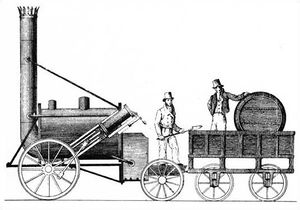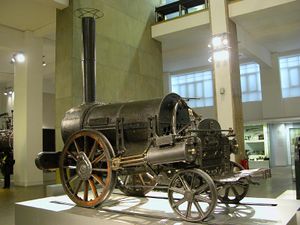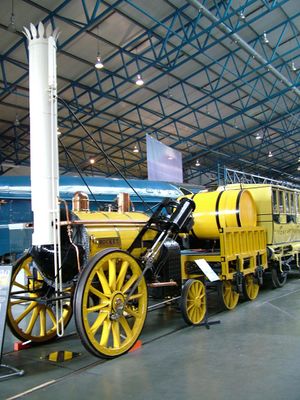Stephenson's Rocket
Stephenson's Rocket was an early steam locomotive of 0-2-2 wheel arrangement, built by George Stephenson in 1829.
Contents
Design innovations
A common misconception is that Rocket was the first steam locomotive. In fact the first steam locomotive to run on tracks was built by Richard Trevithick 25 years earlier, but was not financially successful. George Stephenson, as well as a number of other engineers, had built steam locomotives before. Rocket was in some ways an evolution, not a revolution.
Rocket's claim to fame is that it was the first 'modern' locomotive, introducing several innovations that have been used on almost every steam locomotive built since. In fact, the standard steam locomotive design is often called the "Stephensonian" locomotive. Rocket used a multi-tubular boiler, which made for much more efficient and effective heat transfer between the exhaust gases and the water. Previous boilers consisted of a single pipe surrounded by water. Rocket also used a blastpipe for the first time - using the blast of exhaust steam to induce a partial vacuum to pull air through the fire; credit for the invention of the blastpipe is, however, disputed between Sir Goldsworthy Gurney and Timothy Hackworth.
Nearly all steam locomotives built since have been based upon Rocket's basic design.
History
Rainhill trials
It was designed and built to compete in the Rainhill Trials, a competition to select the locomotive type for the Liverpool and Manchester Railway, on 6 to 14 October 1829. All the other competitors broke down and Rocket was declared the winner. Rocket fulfilled the key requirement of the contest that a full simulated 50 mile (90-km) round trip under load be completed with satisfactory fuel consumption. It averaged 12 miles per hour while hauling 13 tons and 29 miles per hour running alone[1].
At the official opening of the railway almost a year later on 15 September 1830 the first run of Rocket was marred by the first fatal railway accident, the death of William Huskisson MP.
Subsequent service
After service on the Liverpool and Manchester railway, the Rocket was used near Tindale village and on Lord Carlisle's Railway.[2].
Preservation
In 1862 Rocket was donated to the Patent Museum in London by the Thompsons of Milton Hall, near Brampton, in Cumbria.
The locomotive still exists, in the Science Museum, London, in much modified form compared to its state at the Rainhill Trials. The cylinders were altered to the horizontal position, compared to the slanted arrangement as new, and the locomotive was given a proper smokebox. Such are the changes in the engine from 1829 that The Engineer magazine, circa 1884, concluded that it seems to us indisputable that the Rocket of 1829 and 1830 were totally different engines.
The Replica
In 1979 a replica Rocket was built by Locomotion Enterprises for the 150th anniversary celebrations. It has a shorter chimney than the original in order to the clear the bridge at Rainhill: the trackbed is thicker than in the 19th century, giving less headroom.
References
- ↑ Schoolnet article on the Rainhill Trials.
- ↑ Lord Carlisle's Railways. Railway Correspondence & Travel Society. ISBN 0-901115-43-6. p 101.
External links
| Wikimedia Commons has media related to: Stephenson's Rocket |
- The Rocket as QT VR
- Making the Modern World gallery
- Stephenson's Rocket board game by Reiner Knizia
- The Engineer magazine examines the differences between the 1829 and 1830 Rocket, as reprinted in Scientific American Supplement, No. 460, October 25, 1884.
- ScaleModel.NET Gallery 1:26 Scale model of Rocket.
Pre-1830 steam locomotives
|
|---|
|
Pen-y-darren (1804) •
Catch Me Who Can (1808) •
Puffing Billy (1812) •
Wylam Dilly (1812) •
The Salamanca (1812) •
Blücher (1814) •
Locomotion No. 1 (1825) • |
|
See also: Rainhill trials • History of rail transport in Great Britain to 1830 |




